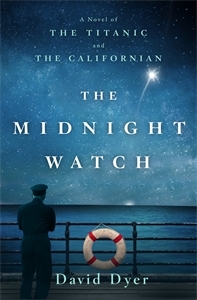About the book:
As the Titanic and her passengers sank slowly into the Atlantic Ocean after striking an iceberg late in the evening of April 14, 1912, a nearby ship looked on. Second Officer Herbert Stone, in charge of the midnight watch on the SS Californian sitting idly a few miles north, saw the distress rockets that the Titanic fired. He alerted the captain, Stanley Lord, who was sleeping in the chart room below, but Lord did not come to the bridge. Eight rockets were fired during the dark hours of the midnight watch, and eight rockets were ignored. The next morning, the Titanic was at the bottom of the sea and more than 1,500 people were dead. When they learned of the extent of the tragedy, Lord and Stone did everything they could to hide their role in the disaster, but pursued by newspapermen, lawyers, and political leaders in America and England, their terrible secret was eventually revealed. The Midnight Watch is a fictional telling of what may have occurred that night on the SS Californian, and the resulting desperation of Officer Stone and Captain Lord in the aftermath of their inaction.
Told not only from the perspective of the SS Californian crew, but also through the eyes of a family of third-class passengers who perished in the disaster, the narrative is drawn together by Steadman, a tenacious Boston journalist who does not rest until the truth is found. The Midnight Watch is a powerful and dramatic debut novel--the result of many years of research in Liverpool, London, New York, and Boston, and informed by the author's own experiences as a ship's officer and a lawyer.
My review:
Parts of this book were really good and others seemed to drag on a bit too long. It read sort of like a whodunnit mystery, but without the red herrings. The many lies and the cover-up testimonies were interesting to read about because the stories kept changing. No one wanted to admit to anything that would make them the cause or contributor to the tragedy and such a great loss of life. I liked reading most of the novel from the point of view of a newspaper reporter. At the same time, I didn't feel like their was enough about the Titanic tragedy itself, as the plot was more focused on the Californian.
Now, technically I understand the intention was to focus on the inaction of the other ship when they saw the rockets, which makes the Titanic's story all the more tragic because the boat was only ten or so miles away and could have saved a good number of passengers had they done something. The feeling I got at the conclusion of this book was more like I'd been reading depositions of the Nazi leaders and their testimonies of their participation in international war crimes at the Nuremberg Trials. So if you find that approach a bit dry, you might not stick with this book until the end.
My favorite part of the story was when the author showed the last hour of the Sage family's life. It was an intriguing perspective of how a large family with nine children might have dealt with the ship's sinking as a unit. Since the eleven member family actually died when the ship disappeared under water, I found it especially intriguing that not one of them survived. They didn't want to be separated even if that meant they could live, and that was an emotional part of the book for me. As a family they fought to stay together despite the hopelessness of their situation. Such a tragic ending.
All in all this was a decent story. Would I rave about it and recommend it to friends? Probably not. But that's just my opinion. What makes a Titanic themed story intriguing is the tragedy and experiencing the events as if you were there as the ship went down. The book did include some of these scenes, but most of the story was about digging up the facts and trying to get to the truth. That's the part that dragged on longer than necessary.
The Midnight Watch was published by St Martin's Press and released in 2016.

No comments:
Post a Comment